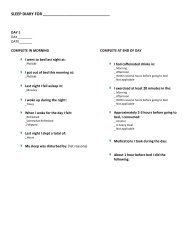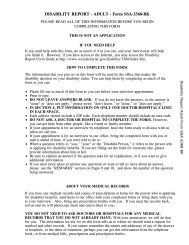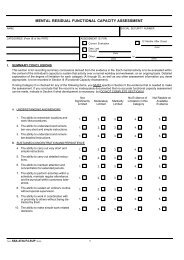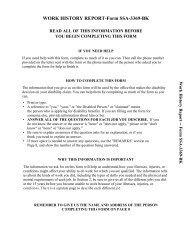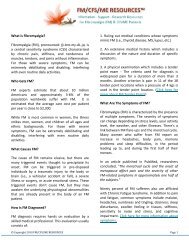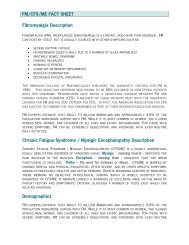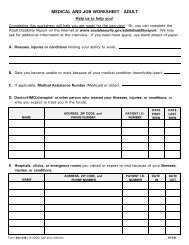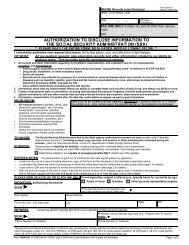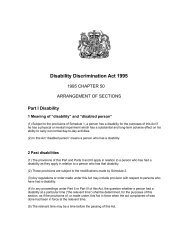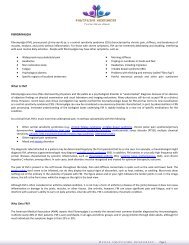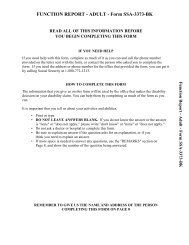HIV Medical Report, SSA 4814-FS - FM/CFS/ME Resources
HIV Medical Report, SSA 4814-FS - FM/CFS/ME Resources
HIV Medical Report, SSA 4814-FS - FM/CFS/ME Resources
Create successful ePaper yourself
Turn your PDF publications into a flip-book with our unique Google optimized e-Paper software.
DEPART<strong>ME</strong>NT OF HEALTH AND HUMAN SERVICES<br />
SOCIAL SECURITY ADMINISTRATION<br />
<strong>ME</strong>DICAL REPORT ON ADULT WITH ALLEGATION OF<br />
HUMAN IMMUNODEFICIENCY VIRUS (<strong>HIV</strong>) INFECTION<br />
DO/BO CODE:<br />
Form Approved<br />
OMB No. 0960-0503<br />
The Individual named below has filed an application for a period of disability and/or disability payments. If you complete<br />
this form, your patient may be able to receive early payments. (This Is not a request for an examination, but for existing<br />
medical information.)<br />
<strong>ME</strong>DICAL RELEASE INFORMATION<br />
Form <strong>SSA</strong>-827, ''Authorization to Release <strong>Medical</strong> Information to the Social Security Administration,'' attached.<br />
I hereby authorize the medical source named below to release or disclose to the Social Security Administration or State<br />
agency any medical records or other information regarding my treatment for human immunodeficiency virus (<strong>HIV</strong>) infection.<br />
CLAIMANT'S SIGNATURE (Required only if Form <strong>SSA</strong>-827 is NOT attached)<br />
DATE<br />
A. IDENTIFYING INFORMATION<br />
<strong>ME</strong>DICAL SOURCE'S NA<strong>ME</strong><br />
CLAIMANT'S NA<strong>ME</strong><br />
CLAIMANT'S SSN<br />
CLAIMANT'S DATE OF BIRTH<br />
B. HOW WAS <strong>HIV</strong> INFECTION DIAGNOSED?<br />
Laboratory testing confirming<br />
<strong>HIV</strong> infection<br />
Other clinical and laboratory findings, medical history,<br />
and diagnosis(es) indicated in the medical evidence<br />
C. OPPORTUNISTIC AND INDICATOR DISEASES: Please check if applicable.<br />
BACTERIAL INFECTIONS<br />
1. MYCOBACTERIAL INFECTION (e.g., caused by<br />
M. avium-intracellulare, M. kansasii, or<br />
M. tuberculosis), at a site other than<br />
the lungs, skin, or cervical or hilar lymph<br />
nodes<br />
11. HISTOPLASMOSIS, at a site other than the lungs or<br />
lymph nodes<br />
12.<br />
MUCORMYCOSIS<br />
PROTOZOAN OR HELMINTHIC INFECTIONS<br />
13. CRYPTOSPORIDIOSIS, ISOSPORIASIS, OR<br />
2. PULMONARY TUBERCULOSIS, resistant to<br />
treatment<br />
MICROSPORIDIOSIS, with diarrhea lasting for<br />
1 month or longer<br />
3. NOCARDIOSIS<br />
14. PNEUMOCYSTIS CARINII PNEUMONIA OR<br />
4. SALMONELLA BACTEREMIA, recurrent non-typhoid<br />
EXTRAPULMONARY PNEUMOCYSTIS CARINII<br />
INFECTION<br />
5. SYPHILIS OR NEUROSYPHILIS<br />
(e.g., meningovascular syphilis) resulting in neurologic 15. STRONGYLOIDIASIS, extra-intestinal<br />
or other sequelae 16. TOXOPLASMOSIS of an organ other than the liver,<br />
6.<br />
MULTIPLE OR RECURRENT BACTERIAL<br />
INFECTION(S), including pelvic inflammatory<br />
disease, requiring hospitalization or intravenous<br />
antibiotic treatment 3 or more times in 1 year<br />
spleen, or lymph nodes<br />
VIRAL INFECTIONS<br />
17. CYTO<strong>ME</strong>GALOVIRUS DISEASE, at a site other than<br />
the liver, spleen, or lymph nodes<br />
FUNGAL INFECTIONS<br />
18. HERPES SIMPLEX VIRUS causing mucocutaneous<br />
7. ASPERGILLOSIS<br />
infection (e.g., oral, genital, perianal) lasting for<br />
8. CANDIDIASIS, at a site other than the skin, urinary<br />
1 month or longer; or infection at a site other than the<br />
tract, intestinal tract, or oral or vulvovaginal mucous<br />
skin or mucous membranes (e.g., bronchitis,<br />
membranes; or candidiasis involving the esophagus,<br />
pneumonitis, esophagitis, or encephalitis); or<br />
trachea, bronchi, or lungs<br />
disseminated infection<br />
9. COCCIDIOIDOMYCOSIS, at a site other than the<br />
lungs or lymph nodes<br />
10. CRYPTOCOCCOSIS, at a site other than the lungs<br />
(e.g., cryptococcal meningitis)<br />
19. HERPES ZOSTER, disseminated or with<br />
multidermatomal eruptions that are resistant to<br />
treatment<br />
20.<br />
PROGRESSIVE MULTIFOCAL<br />
LEUKOENCEPHALOPATHY<br />
Form <strong>SSA</strong>-<strong>4814</strong>-F5 (8-93) Destroy Prior Editions<br />
0012<br />
Page 1
21. HEPATITIS, resulting in chronic liver disease 31. OTHER NEUROLOGICAL MANIFESTATIONS OF<br />
manifested by appropriate findings (e.g., persistent<br />
ascites, bleeding esophageal varices, hepatic<br />
encephalopathy)<br />
MALIGNANT NEOPLASMS<br />
<strong>HIV</strong> INFECTION (e.g., peripheral neuropathy), with<br />
significant and persistent disorganization of motor<br />
function in 2 extremities resulting in sustained<br />
disturbance of gross and dexterous movements, or<br />
gait and station<br />
22. CARCINOMA OF THE CERVIX, invasive,<br />
FIGO stage II and beyond<br />
23.<br />
KAPOSI'S SARCOMA, with extensive oral lesions;<br />
or involvement of the gastrointestinal tract, lungs, or<br />
other visceral organs; or involvement of the skin or<br />
mucous membranes with extensive fungating or<br />
ulcerating lesions not responding to treatment<br />
24. LYMPHOMA of any type (e.g., primary lymphoma<br />
of the brain, Burkitt's lymphoma, immunoblastic<br />
sarcoma, other non-Hodgkins lymphoma, Hodgkin's<br />
disease)<br />
25. SQUAMOUS CELL CARCINOMA OF THE ANUS<br />
SKIN OR MUCOUS <strong>ME</strong>MBRANES<br />
26. CONDITIONS OF THE SKIN OR MUCOUS<br />
<strong>ME</strong>MBRANES, with extensive fungating or<br />
ulcerating lesions not responding to treatment (e.g.,<br />
dermatological conditions such as eczema or<br />
psoriasis, vulvovaginal or other mucosal candida,<br />
condyloma caused by human papillomavirus, genital<br />
ulcerative disease)<br />
HEMATOLOGIC ABNORMALITIES<br />
27. ANEMIA (hematocrit persisting at 30 percent or<br />
less), requiring one or more blood transfusions on an<br />
average of at least once every 2 months<br />
28. GRANULOCYTOPENIA, with absolute neutrophil<br />
3<br />
counts repeatedly below 1,000 cells/mm and<br />
documented recurrent systemic bacterial infections<br />
occurring at least 3 times in the last 5 months<br />
29. THROMBOCYTOPENIA, with platelet counts<br />
3<br />
repeatedly below 40,000/mm ; with at least one<br />
spontaneous hemorrhage, requiring transfusion in<br />
the last 5 months; or intracranial bleeding in the<br />
last 12 months<br />
NEUROLOGICAL ABNORMALITIES<br />
30. <strong>HIV</strong> ENCEPHALOPATHY, characterized by<br />
cognitive or motor dysfunction that limits function<br />
and progresses<br />
<strong>HIV</strong> WASTING SYNDRO<strong>ME</strong><br />
32. <strong>HIV</strong> WASTING SYNDRO<strong>ME</strong>, characterized by<br />
involuntary weight loss of 10 percent or more of<br />
baseline (or other significant involuntary weight loss)<br />
and, in the absence of a concurrent illness that could<br />
explain the findings, involving: chronic diarrhea with<br />
2 or more loose stools daily lasting for 1 month or<br />
longer; or chronic weakness and documented fever<br />
greater than 38º C (100.4º F) for the majority of<br />
1 month or longer<br />
DIARRHEA<br />
33. DIARRHEA, lasting for 1 month or longer, resistant<br />
to treatment, and requiring intravenous hydration,<br />
intravenous alimentation, or tube feeding<br />
34.<br />
35.<br />
CARDIOMYOPATHY<br />
CARDIOMYOPATHY (chronic heart failure, or cor<br />
pulmonale, or other severe cardiac abnormality not<br />
responsive to treatment)<br />
NEPHROPATHY<br />
NEPHROPATHY, resulting in chronic renal failure<br />
INFECTIONS RESISTANT TO TREAT<strong>ME</strong>NT OR<br />
REQUIRING HOSPITALIZATION<br />
OR INTRAVENOUS TREAT<strong>ME</strong>NT<br />
3 OR MORE TI<strong>ME</strong>S IN 1 YEAR<br />
36. SEPSIS<br />
37.<br />
38.<br />
<strong>ME</strong>NINGITIS<br />
PNEUMONIA (non-PCP)<br />
39. SEPTIC ARTHRITIS<br />
40.<br />
ENDOCARDITIS<br />
41. SINUSITIS, radiographically documented<br />
NOTE:<br />
If you have checked any of the boxes in section C, proceed to section E if you have any remarks you wish to<br />
make about this patient's condition. Then, proceed to sections F and G and sign and date the form.<br />
If you have not checked any of the boxes in section C, please complete section D. See part VI of the instruction<br />
sheet for definitions of the terms we use in section D. Proceed to section E if you have any remarks you wish<br />
to make about this patient's condition. Then, proceed to sections F and G and sign and date the form.<br />
Form <strong>SSA</strong>-<strong>4814</strong>-F5 (8-93) Page 2<br />
0012
D. OTHER MANIFESTATIONS OF <strong>HIV</strong> INFECTION<br />
42. a. REPEATED MANIFESTATIONS OF <strong>HIV</strong> INFECTION, including diseases mentioned in section C, items 1-41, but without<br />
the specified findings described above, or other diseases, resulting in significant, documented, symptoms or signs (e.g.,<br />
fatigue, fever, malaise, weight loss, pain, night sweats).<br />
Please specify:<br />
1. The manifestations your patient has had;<br />
2. The number of episodes occurring in the same 1-year period; and<br />
3. The approximate duration of each episode.<br />
Remember, your patient need not have the same manifestation each time to meet the definition of repeated manifestations;<br />
but, all manifestations used to meet the requirement must have occurred in the same 1-year period. (See attached<br />
instructions for the definition of repeated manifestations.)<br />
If you need more space, please use section E.<br />
EXAMPLE: Diarrhea<br />
MANIFESTATIONS:<br />
NO. OF EPISODES IN<br />
THE SA<strong>ME</strong> 1-YEAR PERIOD:<br />
3<br />
DURATION<br />
OF EACH EPISODE:<br />
1 month each<br />
____ AND<br />
b. ANY OF THE FOLLOWING:<br />
Marked restriction of ACTIVITIES OF DAILY LIVING; or<br />
Marked difficulties in maintaining SOCIAL FUNCTIONING; or<br />
Marked difficulties in completing tasks in a timely manner due to deficiencies in CONCENTRATION,<br />
PERSISTENCE, OR PACE.<br />
E. REMARKS: (Please use this space if you lack sufficient room in section D or to provide any other comments you wish about your<br />
patient.)<br />
F. <strong>ME</strong>DICAL SOURCE'S NA<strong>ME</strong> AND ADDRESS (Print or type) TELEPHONE NUMBER (Area Code)<br />
DATE<br />
KNOWING THAT ANYONE MAKING A FALSE STATE<strong>ME</strong>NT OR REPRESENTATION OF A MATERIAL FACT FOR USE IN<br />
DETERMINING A RIGHT TO PAY<strong>ME</strong>NT UNDER THE SOCIAL SECURITY ACT COMMITS A CRI<strong>ME</strong> PUNISHABLE UNDER<br />
FEDERAL LAW, I CERTIFY THAT THE ABOVE STATE<strong>ME</strong>NTS ARE TRUE.<br />
G. SIGNATURE AND TITLE (e.g., physician, R.N.) OF PERSON COMPLETING THIS FORM<br />
FOR<br />
OFFICIAL<br />
USE<br />
ONLY<br />
FIELD OFFICE DISPOSITION:<br />
DISABILITY DETERMINATION SERVICES DISPOSITION:<br />
Form <strong>SSA</strong>-<strong>4814</strong>-F5 (8-93) Page 3<br />
0012
<strong>ME</strong>DICAL SOURCE INSTRUCTION SHEET FOR COMPLETION OF ATTACHED <strong>SSA</strong>-<strong>4814</strong>-F5<br />
(<strong>Medical</strong> <strong>Report</strong> On Adult With Allegation Of Human Immunodeficiency Virus (<strong>HIV</strong>) Infection)<br />
Your patient, identified in section A of the attached form, has filed a claim for Supplemental Security Income disability payments<br />
based on <strong>HIV</strong> infection. <strong>ME</strong>DICAL SOURCE: Please detach this instruction sheet and use it to complete the attached form.<br />
I.<br />
II.<br />
PURPOSE OF THIS FORM:<br />
IF YOU COMPLETE AND RETURN THE ATTACHED FORM PROMPTLY, YOUR PATIENT MAY BE ABLE TO RECEIVE<br />
PAY<strong>ME</strong>NTS WHILE WE ARE PROCESSING HIS OR HER CLAIM FOR ONGOING DISABILITY PAY<strong>ME</strong>NTS.<br />
This is not a request for an examination. At this time, we simply need you to fill out this form based on existing medical<br />
information. The State Disability Determination Services will contact you later to obtain further evidence needed to process<br />
your patient's claim.<br />
WHO MAY COMPLETE THIS FORM:<br />
A physician, nurse, or other member of a hospital or clinic staff, who is able to confirm the diagnosis and severity of the <strong>HIV</strong><br />
disease manifestations based on your records, may complete and sign the form.<br />
III.<br />
<strong>ME</strong>DICAL RELEASE:<br />
An <strong>SSA</strong> medical release (an <strong>SSA</strong>-827) signed by your patient should be attached to the form when you receive it. If the<br />
release is not attached, the medical release section on the form itself should be signed by your patient.<br />
IV. HOW TO COMPLETE THE FORM:<br />
• If you receive the form from your patient and section A has not been completed, please fill in the identifying information<br />
about your patient.<br />
• You may not have to complete all of the sections on the form.<br />
• ALWAYS COMPLETE SECTION B.<br />
• COMPLETE SECTION C, IF APPROPRIATE. If you check at least one of the items in section C, go right to section E.<br />
•<br />
V.<br />
•<br />
•<br />
COMPLETE SECTION E IF YOU WISH TO PROVIDE COM<strong>ME</strong>NTS ON YOUR PATIENT'S CONDITION(S).<br />
ALWAYS COMPLETE SECTIONS F AND G. NOTE: This form is not complete until it is signed.<br />
HOW TO RETURN THE FORM TO US :<br />
•<br />
•<br />
ONLY COMPLETE SECTION D IF YOU HAVE NOT CHECKED ANY ITEM IN SECTION C. See the special information<br />
below which will help you to complete section D.<br />
Mail the completed, signed form, as soon as possible, in the return envelope provided.<br />
If you received the form from your patient without a return envelope, give the completed, signed form back to your patient<br />
for return to the <strong>SSA</strong> field office.<br />
VI.<br />
SPECIAL INFORMATION TO HELP YOU COMPLETE SECTION D<br />
HOW WE USE SECTION D:<br />
•<br />
Section D asks you to tell us what other manifestations of <strong>HIV</strong> your patient may have. It also asks you to give us an idea of<br />
how your patient's ability to function has been affected.<br />
•<br />
We do not need detailed descriptions of the functional limitations imposed by the illness; we just need to know whether your<br />
patient's ability to function has been affected to a "marked" degree in any of the areas listed. See below for an explanation<br />
of the term ''marked.''<br />
SPECIAL TERMS USED IN SECTION D<br />
WHAT WE <strong>ME</strong>AN BY ''REPEATED'' MANIFESTATIONS OF <strong>HIV</strong> INFECTION: (See Item 42.a)<br />
"Repeated" means that a condition or combination of conditions:<br />
• Occurs an average of 3 times a year, or once every 4 months, each lasting 2 weeks or more; or<br />
• Does not last for 2 weeks, but occurs substantially more frequently than 3 times in a year or once every 4 months; or<br />
•<br />
Occurs less often than an average of 3 times a year or once every 4 months but lasts substantially longer than 2 weeks.<br />
WHAT WE <strong>ME</strong>AN BY ''MANIFESTATIONS OF <strong>HIV</strong> INFECTION": (See Item 42.a)<br />
• "Manifestations of <strong>HIV</strong> infection" may include:<br />
Any condition listed in section C, but without the findings specified there (e.g., carcinoma of the cervix not meeting the<br />
criteria shown in item 22 of the form, diarrhea not meeting the criteria shown in item 33 of the form); or any other<br />
condition that is not listed in section C (e.g., oral hairy leukoplakia, myositis).<br />
• Manifestations of <strong>HIV</strong> must result in significant, documented, symptoms and signs (e.g., fatigue, fever, malaise, weight loss,<br />
pain, night sweats).<br />
Form <strong>SSA</strong>-<strong>4814</strong>-F5 (8-93) Destroy Prior Editions<br />
0012<br />
Continued on the reverse<br />
4
WHAT WE <strong>ME</strong>ANT BY "MARKED" LIMITATION OR RESTRICTION IN FUNCTIONING: (See Item 42.b)<br />
• When "marked" is used to describe functional limitations, it means more than moderate, but less than extreme. ''Marked''<br />
does not imply that your patient is confined to bed, hospitalized, or in a nursing home.<br />
• A marked limitation may be present when several activities or functions are impaired or even when only one is impaired. An<br />
individual need not be totally precluded from performing an activity to have a marked limitation, as long as the degree of<br />
limitation is such as to seriously interfere with the ability to function independently, appropriately, and effectively.<br />
WHAT WE <strong>ME</strong>AN BY ''ACTIVITIES OF DAILY LIVING'': (See Item 42.b)<br />
• Activities of daily living include, but are not limited to, such activities as doing household chores, grooming and hygiene,<br />
using a post office, taking public transportation, and paying bills.<br />
• EXAMPLE: An individual with <strong>HIV</strong> infection who, because of symptoms such as pain imposed by the illness or its<br />
treatment, is not able to maintain a household or take public transportation on a sustained basis or without assistance (even<br />
though he or she is able to perform some self-care activities) would have marked limitation of activities of daily living.<br />
•<br />
•<br />
WHAT WE <strong>ME</strong>AN BY ''SOCIAL FUNCTIONING'': (See Item 42.b)<br />
Social functioning includes the capacity to interact appropriately and communicate effectively with others.<br />
EXAMPLE: An individual with <strong>HIV</strong> infection who, because of symptoms or a pattern of exacerbation and remission caused<br />
by the illness or its treatment, cannot engage in social interaction on a sustained basis (even though he or she is able to<br />
communicate with close friends or relatives) would have marked difficulty maintaining social functioning.<br />
WHAT WE <strong>ME</strong>AN BY ''COMPLETING TASKS IN A TI<strong>ME</strong>LY MANNER'': (See Item 42.b)<br />
• Completing tasks in a timely manner involves the ability to sustain concentration, persistence, or pace to permit timely<br />
completion of tasks commonly found in work settings.<br />
• EXAMPLE: An individual with <strong>HIV</strong> infection who, because of <strong>HIV</strong>-related fatigue or other symptoms, is unable to sustain<br />
concentration or pace adequate to complete simple work-related tasks (even though he or she is able to do routine activities<br />
of daily living) would have marked difficulty completing tasks.<br />
PRIVACY ACT NOTICE: The Social Security Administration is authorized to collect the information on this form under sections<br />
205(a), 223(d) and 1633(e)(1) of the Social Security Act. The information on this form is needed by Social Security to make a<br />
decision on the named claimant's claim. While giving us the information on this form is voluntary, failure to provide all or part of<br />
the requested information could prevent an accurate or timely decision on the named claimant's claim. Although the information<br />
you furnish is almost never used for any purpose other than making a determination about the claimant's disability, such<br />
information may be disclosed by the Social Security Administration as follows: (1) to enable a third party or agency to assist Social<br />
Security in establishing rights to Social Security benefits and/or coverage; (2) to comply with Federal laws requiring the release of<br />
information from Social Security records (e.g., to the General Accounting Office and the Department of Veterans Affairs); and (3)<br />
to facilitate statistical research and audit activities necessary to assure the integrity and improvement of the Social Security<br />
programs (e.g., to the Bureau of the Census and private concerns under contract to Social Security).<br />
We may also use the information you give us when we match records by computer. Matching programs compare our records with<br />
those of other Federal, State, or local government agencies. Many agencies may use matching programs to find or prove that a<br />
person qualifies for benefits paid by the Federal government. The law allows us to do this even if you do not agree to it.<br />
Explanations about these and other reasons why information you provide us may be used or given out are available in Social<br />
Security offices. If you want to learn more about this, contact any Social Security office.<br />
TI<strong>ME</strong> IT TAKES TO COMPLETE THIS FORM<br />
We estimate that it will take you about 10 minutes to complete this form. This includes the time it will take to read the instructions,<br />
gather the necessary facts, and fill out the form. If you have comments or suggestions on this estimate or on any other aspect of<br />
this form, write to the Social Security Administration, ATTN: <strong>Report</strong>s Clearance Officer, 1-A-21 Operations Bldg., Baltimore, MD<br />
21235-0001, and to the Office of Management and Budget, Paperwork Reduction Project (0960-0503), Washington, D.C. 20503.<br />
SEND ONLY COM<strong>ME</strong>NTS RELATING TO OUR ESTIMATE OR OTHER ASPECTS OF THIS FORM TO THE OFFICES<br />
LISTED ABOVE. ALL REQUESTS FOR SOCIAL SECURITY CARDS AND OTHER CLAIMS-RELATED INFORMATION<br />
SHOULD BE SENT TO YOUR LOCAL SOCIAL SECURITY OFFICE, WHOSE ADDRESS IS LISTED IN YOUR<br />
TELEPHONE DIRECTORY UNDER THE DEPART<strong>ME</strong>NT OF HEALTH AND HUMAN SERVICES.<br />
Form <strong>SSA</strong>-<strong>4814</strong>-F5 (8-93) *U.S. Government Printing Office: 1993 — 342-256/80130<br />
0012



